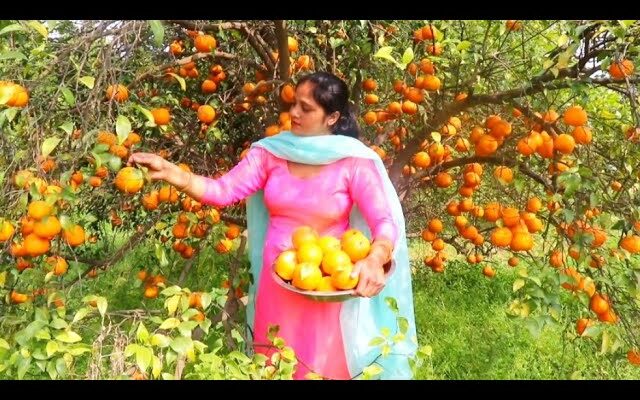
With most orange cultivation occurring in the states of Maharashtra, Telangana, Andhra Pradesh, and Madhya Pradesh, India is one of the world’s top producers of oranges. Because of their high vitamin C content, oranges are a popular fruit that are a staple in many homes. Here is a thorough guide to get you started if you’re thinking about starting an orange farm or want to make improvements to your current farm.
India’s Orange Varieties In India, oranges come in a variety of popular varieties. Valencia oranges, blood oranges, and Nagpur oranges are a few of the most widely grown types. Blood oranges have a distinctive red colour and a sweet-tart flavour, while Nagpur oranges prized for their juicy, sweet taste. Valencia oranges have a lot of juice, so people use them for juicing a lot.
Orange’s Climate Agriculture Most orange trees grown in warm, humid climates. The optimal temperature range in India to cultivate oranges is 15°C to 38°C. The monsoon season, which normally lasts from June to September, is the ideal time of year to plant orange trees.
The Soil Needed for Growing Oranges Rich in organic matter and well-drained, these soils are ideal for growing oranges. 5.5 to 7.5 is the ideal pH range for growing oranges. Additionally, there should be no illnesses or pests in the soil.
Popular Varieties of Sweet Oranges
Satthgudi
Grown widely throughout South India (AP), the juicy and delicious sweet orange has a globular form and a thin, semi-glossy peel. It highly sought after. When fully ripe, oranges can weigh between 140 and 160 grams and contain few or no seeds. It sliced into ten or twelve portions with a juice content of 49 percent. Sathgudi is the region that yields the most delicious oranges.
Batavian
The popular Andhra Pradesh sweet orange variety, though similar in many ways to Sathgudi, frequently has yellow spots growing against a green background. Most Batavian orange trees planted near the coast, where they adequately protected from the area’s sucking moths.
Mosambi
It grows a round shape and rough, thick skin. Mosambi has a 0.45% acidity level, a sweet taste, and about 43% juice. It weighs between 150 and 220 grams, which is more than Sathugadi and has a higher seed content. Maharashtra is where most of it grown.
Malta
Citrus fruit, or Malta, is native to India. The term sangtra often used to describe it. It occupies about 30% of the total area used for citrus cultivation. India is a commercial citrus cultivation country, home to mandarin and sweet orange trees. Every year, more mandarin oranges produced in the country’s western and central regions. India ranks third in the world for orange production, behind the fruits of the mango and banana. Oranges grown in the Indian states of Rajasthan, Himachal Pradesh, Punjab, and Uttar Pradesh.
Conditions for Growing Sweet Oranges
Loamy, well-drained soil with a uniform texture up to two to three metres below the topsoil is ideal for growing sweet oranges. Furthermore, it can only be planted on heavy soils provided it can drain adequately; nevertheless, the yield it yields is frequently less than that of the former. Maintain the pH of the soil between 6.5 and 7.5 for optimal yield.
Climate:
Growers can grow the premium sweet oranges that the market demands with a tropical to semi-tropical climate and 600–700 mm of annual precipitation. The ideal temperature range for the best outcomes is between thirty and forty degrees.
Setting Up the Land
The agricultural field should be ploughed to a fine tilt up to deep earth, and then each seedling should have a trench dug measuring one square metre. To protect plants from fungal infection, fill the holes before planting with topsoil that has thoroughly mixed with 15-20 kg of FYM, 500–600 grams of superphosphate, and 30 grams of methyl parathion@2%.
Planting Duration and Alignment
The months of July through December are ideal for planting. When planting, keep the bud junction above the soil line. Regularly water and stake developing seedlings to prevent damage from wind. Keep the distance between each plant at 6 m × 6 m.
Intercrops
Producing income through intercropping is particularly beneficial when sweet oranges are approaching pre-bearing maturity. Consider growing both short-term leguminous plants, such as cowpea, beans, Bengal gramme, and cluster beans, and cucurbitaceous plants. For intercropping, you can use any top brand mini tractor.
Harvesting
Pretty much every sweet orange bears fruit after the fourth year. Fruit size, smooth rinds, and juice content can all be increased by spraying them with potassium nitrate one month prior to harvesting, at a rate of 5–10 grams per liter of water. South India plants two crop cycles annually, the first from March to May and the second from August to September, thanks to the benefits of its climate. It estimated that the average output per acre is in the range of 16–20 tonnes.
These are all about Orange Farming in India: A Comprehensive Guide for Farmers. For more information about agriculture and Mahindra tractor, stay connected with us.











